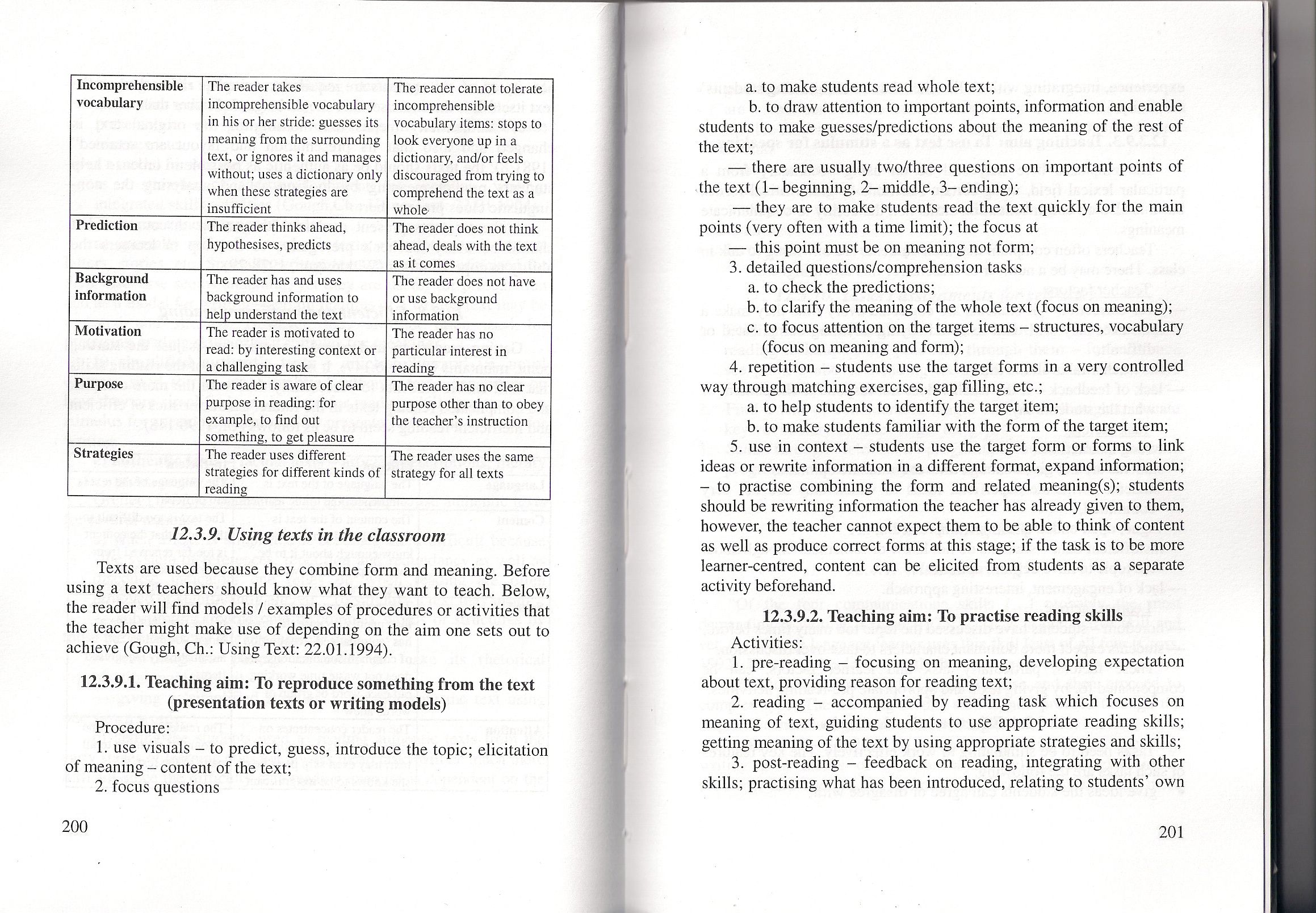88678 skanowanie0100 (2)

|
Incomprehensible yocabułary |
The reader takes incomprehensible yocabułary in his or her stride: guesses its meaning from the surrounding text, or ignores it and manages without; uses a dictionary only when these strategies are insufficient |
The reader cannot tolerate incomprehensible yocabułary items: stops to look everyone up in a dictionary, and/or feels discouraged from trying to comprehend the text as a whole- |
|
Prediction |
The reader thinks ahead, hypothesises, predicts |
The reader does not think ahead, deals with the text as it comes |
|
Background information |
The reader has and uses background information to help understand the text |
The reader does not have or use background information |
|
Motivation |
The reader is motivated to read: by interesting context or a challenging task |
The reader has no particular interest in reading |
|
Purpose |
The reader is aware of elear purpose in reading: for example, to find out something, to get pleasure |
The reader has no elear purpose other than to obey the teacher’s instruction |
|
Strategies |
The reader uses different strategies for different kinds of reading |
The reader uses the same strategy for all texts |
12.3.9. Using texts in the classroom
Texts are used because they combine form and meaning. Before using a text teachers should know what they want to teach. Belo w, the reader will find models / examples óf procedures or activities that the teacher might make use of depending on the aim one sets out to achieve (Gough, Ch.: Using Text: 22.01.1994).
12.3.9.1. Teaching aim: To reproduce something from the text (presentation texts or writing models)
Procedurę:
1. use visuals - to predict, guess, introduce the topie; elicitation of meaning - content of the text;
2. focus ąuestions
a. to make students read whole text;
b. to draw attention to important points, information and enable students to make guesses/predictions about the meaning of the rest of the text;
— there are usually two/three ąuestions on important points of the text (1- beginning, 2- middle, 3- ending);
— they are to make students read the text ąuickly for the main points (very often with a time limit); the focus at
— this point must be on meaning not form;
3. detailed ąuestions/comprehension tasks
a. to check the predictions;
b. to clarify the meaning of the whole text (focus on meaning);
c. to focus attention on the target items - structures, yocabułary (focus on meaning and form);
4. repetition - students use the target forms in a very controlled way through matching exercises, gap filling, etc.;
a. to help students to identify the target item;
b. to make students familiar with the form of the target item;
5. use in context - students use the target form or forms to link ideas or rewrite information in a different format, expand information; - to practise combining the form and related meaning(s); students should be rewriting information the teacher has already given to them, however, the teacher cannot expect them to be able to think of content as well as produce correct forms at this stage; if the task is to be morę leamer-centred, content can be elicited from students as a separate activity beforehand.
12.3.9.2. Teaching aim: To practise reading skills
Activities:
1. pre-reading — focusing on meaning, developing expectation about text, providing reason for reading text;
2. readingfi accompanied by reading task which focuses on meaning of text, guiding students to use appropriate reading skills; getting meaning of the text by using appropriate strategies and skills;
3. post-reading - feedback on reading, integrating with other skills; practising what has been introduced, relating to students’ own
201
Wyszukiwarka
Podobne podstrony:
File0030 1 Gel readv to LISTEN Work in pairs. Answer the questions. 1 Do you live
732 KONETT AMTUNOS HATZOPOULOS 12 The same historian, this time in his work on the Greek Bevolu
money that co mes into company from sales less the money which goes out in purchases or overhead exp
tembt2 ASSAB TEMPEForging and hardening colours The STEEL should be viewed in a dark or faintly ligh
39 (241) PediculosisAetiopathogenesis Pediculosis is now rare in the cat and seen only in kittens or
skanowanie0095 (2) “[g]ood readers become autonomous, able to read outside the classroom and to stay
skanowanie0095 (2) “[g]ood readers become autonomous, able to read outside the classroom and to stay
skanowanie0103 (2) 12.4.3. Writing activities There are many different activities that students can
skanowanie0088 (2) To ensure proper understanding of his intentions, the author brings the readers t
skanowanie0103 (2) 12.4.3. Writing activities There are many different activities that students can
351 (20) 324Dress Accessońes Cockerel 1605 SWA81 3285 (2112) 12 fig 212 Incomplete; modelled in
img002 Reąuirements:Tatting Skills assumed: The reader should bc able to tat at a beginner level, in
więcej podobnych podstron